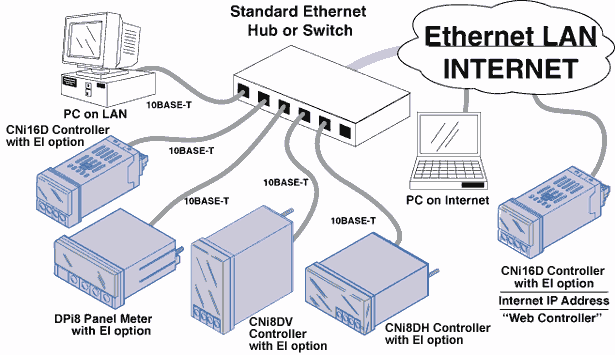ETHERNET
Ethernet is the most popular physical layer LAN technology in use today. Other LAN types include Token Ring, Fast Ethernet, Fiber Distributed Data Interface (FDDI), Asynchronous Transfer Mode (ATM) and LocalTalk. Ethernet connection is popular because it strikes a good balance between speed, cost and ease of installation. These benefits, combined with wide acceptance in the computer marketplace and the ability to support virtually all popular network protocols, make Ethernet an ideal networking technology for most computer users today. The Institute for Electrical and Electronic Engineers (IEEE) defines the Ethernet standard as IEEE Standard 802.3. This standard defines rules for configuring an Ethernet network as well as specifying how elements in an Ethernet network interact with one another. By adhering to the IEEE standard, network equipment and network protocols can communicate efficiently.
Fast Ethernet
For Ethernet networks that need higher transmission speeds, the Fast Ethernet standard (IEEE 802.3u) has been established. This standard raises the Ethernet speed limit from 10 Megabits per second (Mbps) to 100 Mbps with only minimal changes to the existing cable structure. There are three types of Fast Ethernet: 100BASE-TX for use with level 5 UTP cable, 100BASE-FX for use with fiber-optic cable, and 100BASE-T4 which utilizes an extra two wires for use with level 3 UTP cable. The 100BASE-TX standard has become the most popular due to its close compatibility with the 10BASE-T Ethernet standard. For the network manager, the incorporation of Fast Ethernet into an existing configuration presents a host of decisions. Managers must determine the number of users in each site on the network that need the higher throughput, decide which segments of the backbone need to be reconfigured specifically for 100BASE-T and then choose the necessary hardware to connect the 100BASE-T segments with existing 10BASE-T segments. Gigabit Ethernet is a future technology that promises a migration path beyond Fast Ethernet so the next generation of networks will support even higher data transfer speeds.
Ethernet Cabling
Now to familiarize you with more on the Ethernet and it's cabling we need to look at the 10's. 10Base2, is considered the thin Ethernet, thinnet, and thinwire which uses light coaxial cable to create a 10 Mbps network. The cable segments in this network can't be over 185 meters in length. These cables connect with the BNC connector. Also as a note these unused connection must have a terminator, which will be a 50-ohm terminator.
10Base5, this is considered a thicknet and is used with coaxial cable arrangement such as the BNC connector. The good side to the coaxial cable is the high-speed transfer and cable segments can be up to 500 meters between nodes/workstations. You will typically see the same speed as the 10Base2 but larger cable lengths for more versatility.
10BaseT, the “T” stands for twisted as in UTP (Unshielded Twisted Pair) and uses this for 10Mbps of transfer. The down side to this is you can only have cable lengths of 100 meters between nodes/workstations. The good side to this network is they are easy to set up and cheap! This is why they are so common an ideal for small offices or homes.
100BaseT, is considered Fast Ethernet uses STP (Shielded Twisted Pair) reaching data transfer of 100Mbps. This system is a little more expensive but still remains popular as the 10BaseT and cheaper than most other type networks. This on of course would be the cheap fast version.
10BaseF, this little guy has the advantage of fiber optics and the F stands for just that. This arrangement is a little more complicated and uses special connectors and NIC's along with hubs to create its network. Pretty darn neat and not to cheap on the wallet.
An important part of designing and installing an Ethernet is selecting the appropriate Ethernet medium. There are four major types of media in use today: Thickwire for 10BASE5 networks, thin coax for 10BASE2 networks, unshielded twisted pair (UTP) for 10BASE-T networks and fiber optic for 10BASE-FL or Fiber-Optic Inter-Repeater Link (FOIRL) networks. This wide variety of media reflects the evolution of Ethernet and also points to the technology's flexibility. Thickwire was one of the first cabling systems used in Ethernet but was expensive and difficult to use. This evolved to thin coax, which is easier to work with and less expensive.


Are you looking for the best Azure Training in ChennaiHere is the best suggestion for you, Infycle Technologies the best Software training institute in Chennai to study Azure platform with the top demanding courses such as Graphic Design and Animation, Cyber Security, Blockchain, Data Science, Oracle, AWS DevOps, Python, Big data, Python, Selenium Testing, Medical Coding, etc., with best offers. To know more about the offers, approach us on +91-7504633633, +91-7502633633.
ReplyDelete